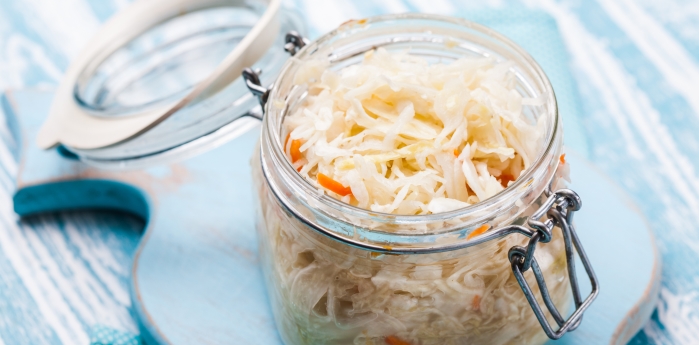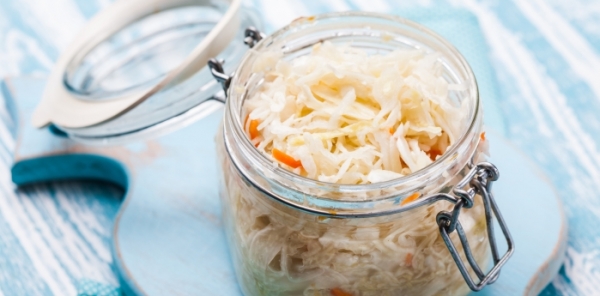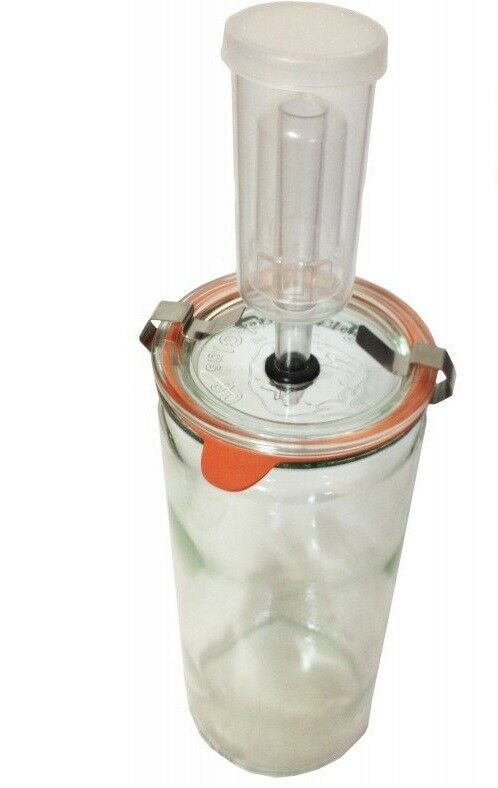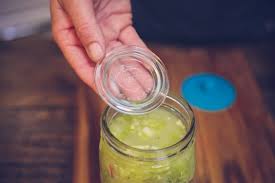Sauerkraut

Sauerkraut is a condiment suggested to be eaten as a side dish whenever meat is consumed and especially at the end of the day when the body’s enzyme storage is depleted having already been expended on previous meals earlier in the day. The evening meal is often the most difficult for people who suffer from digestive disorders or associated disease due to the discomfort it can create during digestion. Therefore, the GAPS Program uses sauerkraut is a natural aid for digestion in stimulating the production of stomach acid.
According to Nutritional data, sauerkraut provides 102% of the recommended daily intake of vitamin K, 35 % of vitamin C and 12% of iron. It also contains only 32 calories with 4 grams of fibre.
Sauerkraut & How to introduce it
Initially just add juice from the sauerkraut into your patient’s meals; then gradually introduce the cabbage itself. Start with as little as 1-2 teaspoons of the juice a day for 2-5 days, then 3-4 teaspoons a day for 2-5 days and so on until you can add a few teaspoons of the Probiotic food into every cup of meat stock and every bowl of soup. Do not add juice or kraut to hot food. The general rule is, if you can put your finger in the soup and it does not burn then its cool enough to add the juice or kraut.
Majority of GAPS patients have low stomach acid production, which starts the whole digestive process from the wrong foot. Regular consumption of sauerkraut over time will help your patient to stimulate and restore stomach acid production and will assist in digesting meats.
Sauerkraut is used in the GAPS diet because it is a digestive and detoxifying food. It is important to make your own because commercial varieties may have been pasteurised or processed in some way which will have no benefits or live enzymes available. If you are buying a commercial brand, select organic raw unpasturised sauerkraut.
Sauerkraut does not require adding any fermenting bacteria to it, as cabbage and other fresh vegetables have these bacteria naturally living on their surface and the salt helps to preserve it. The salt will stifle any putrefactive microbes until the good bacteria produce enough lactic acid to kill them. Another important point is to knead the mixture very well in a large bowl using your hands; you may want to ask somebody with strong hands to do that for you. Knead until the cabbage releases a lot of juice (salt in the mixture will help to do that), so when you leave it to ferment, the cabbage is completely drowned in its own juice.
If for whatever reason there is not enough juice in the cabbage, add some salted water to the mixture. Fermentation is an anaerobic process: if the cabbage is exposed to air, it will rot and not ferment. Having made the sauerkraut once, you will see just how easy it is to do and how little time it takes to make this wonderful healing remedy.
Strain the juice and store it in the fridge for the introduction diet.
If you run out of sauerkraut juice on the introduction diet see our sauerkraut juice recipe?
Alternatives to Sauerkraut
Some people with severe thyroid issues need to start with other fermented vegetables first and these include the GAPS Vegetable Medley and other fermented Vegetables (see below). When some healing has taken place, you may be able to introduce the sauerkraut starting with the juice first.
Wild vegetable fermentation verses culturing vegetable fermentation methods
Wild fermentation is specific to the live organisms naturally present on the raw vegetables. This is the traditional way to ferment vegetables and make sauerkraut because there are abundant lactic acid bacteria on all plants and if submerged under its own juices with a good coverage of salt (regardless of what type vessel they are contained in) the molds cannot grow on them and lactic acid will dominate.
Culturing fermentation is specific to the introduction of specific isolated organisms to inoculate the fermentation process. These are specific to any microbial starters and they may include a commercial bacteria culture starter or a small portion from your previous fermentation batch such as sauerkraut juice or other fermented vegetable medley juice or whey dripped from yoghurt. It is true, you can culture vegetables with whey or powdered commercial starters to add specific strains of bacteria but they are not absolute or necessary to inoculate the fermentation process if done correctly. Fermentation is an art and you will discover which fermentation method you prefer.

| Servings |
Litre
|
- 1 Organic Green Cabage Select fresh organic only to enable enough juice extraction
- 15 - 30 grams Celtic or Himalayan Sea Salt 15 grams (max 15 grams) per 1 kg cabbage
- 1-2 satchals Vegetable Culture Starter Optional depending on whether you are using a wild or culture fermentation method
- 1 Tsp Dill Optional
- 1 Fermentation Vessel A glass jar or crock with a weight to hold the vegetables submerged under the brine and an airlock system with a release valve to allow air to escape whilst creating an anaerobic environment. Refer to Weck images below
- 1 Mandolin For slicing cabage (or use a knife)
Ingredients
Sauerkraut
Sauerkraut Equipment
|

|
- Thinly slice or shred the cabbage with a knife or mandolin. I like to use a mandolin.
- Place the shredded cabbage in a large glass bowl and add the dill (optional).
- For Wild Fermentation, add a generous amount of salt to the cabbage and mix it through with your hands to allow an overall coverage. Let it sit for 15 – 20 minutes to allow the salt to draw out some of the cabbage juice naturally. 5-8grams - (max 15grams) per 1kg cabbage. HINTS: Salt allows the cabbage to sweat so that juices can be extracted to create the brine. For Cultured fermentation, add the commercial culture starter as per packet instructions.

- Mix, massage and knead the ingredients with your hands. Bruising the cabbage this way allows the cabbage to extract a natural brine solution. Keep kneading until you have squeezed a substantial amount of juice from the mixture. Sometimes this may take 10-20 minutes. HINTS: It is beneficial to have someone with strong hands to do the kneading & massaging.
- Place mixture into the selected fermenting vessel and pack and push the mixture down so that the cabbage is compacted in the bottom and the juice is sitting on the top of the cabbage with a minimum of 4 - 5cm’s or 2 inches. It is important to push the cabbage down firmly so that no air is trapped and the cabbage is completely submerged in and under its own brine juice. HINTS: If for any reason the cabbage is not submerged under enough of its own juices, you may need to add a small amount of filtered water with more salt (15 gms of salt to 1 ltr).
- Place the weight on the top of the cabbage to keep all the cabbage submerged. Push the weight down and you will see more juice rise to the top. It is very important to ensure that all the sauerkraut is submerged under its own juice. If any bits of cabbage float up to the surface, remove them throughout the fermentation process to prevent them from going moldy.

- If you use a canning jar with a rubber ring top, and close the lid, be sure to burp it a few times in the first few days to release the pressure. If using the weck airlock system which has it's own release valve allowing gasses to escape without letting air into the jar, place the rubber ring around the top and clamp down the lid with the attached release valve to the top. Store in a dark place for one to two weeks (ie pantry).
- The sauerkraut may be consumed and ready to eat after 5-7 days but it matures better with age so it is good to wait the full two weeks unless the outside temperature is hot which will speed up the fermentation process.
- The sauerkraut may be stored in the fridge after 1-2 weeks of fermentation. If there is any scum or mold development on the top – remove this. The kraut remaining under the juice will be fine.
Optional: It is also nice to add a little grated carrot to your sauerkraut.


